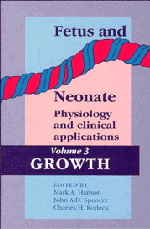Book contents
- Frontmatter
- Contents
- Preface to the series
- List of contributors
- Part I Physiology
- Part II Pathophysiology
- 6 Experimental restriction of fetal growth
- 7 Placental changes in fetal growth retardation
- 8 Human fetal blood gases, glucose, lactate and amino acids in IUGR
- 9 Glucose and fetal growth derangement
- 10 Fetal programming of human disease
- Part III Clinical applications
- Index
6 - Experimental restriction of fetal growth
from Part II - Pathophysiology
Published online by Cambridge University Press: 04 August 2010
- Frontmatter
- Contents
- Preface to the series
- List of contributors
- Part I Physiology
- Part II Pathophysiology
- 6 Experimental restriction of fetal growth
- 7 Placental changes in fetal growth retardation
- 8 Human fetal blood gases, glucose, lactate and amino acids in IUGR
- 9 Glucose and fetal growth derangement
- 10 Fetal programming of human disease
- Part III Clinical applications
- Index
Summary
Introduction
Restricted fetal growth is common in human pregnancy and is associated with increased perinatal morbidity and mortality and an increased risk of adverse outcomes in later life. Similarly, restricted fetal growth in domestic animals results in poor perinatal outcome and reduced productivity. The term ‘restricted fetal growth’ is used increasingly in preference to ‘intrauterine growth retardation’, since the latter has unfortunate connotations for consumers of health services. To prevent, diagnose and treat restricted fetal growth successfully, greater understanding of its origins and consequences, as well as careful evaluation of potential therapeutic strategies, is needed. The study of experimental restriction of fetal growth in animals is an essential element in obtaining this knowledge.
Experimentally, the approaches used to restrict fetal growth in animals reflect the different questions being asked. Some are devised to mimic known or suspected causes of naturally occurring fetal growth restriction, to determine if such factors are involved causatively by imposing them for varying periods at different stages of development. Some perturbations can be produced chronically, and are used to examine the consequences for the individual in the medium to long term. Yet others are designed to identify/delineate the specific physiological, cellular and molecular mechanisms by which perturbations restrict growth and alter development of key fetal organs and tissues.
This chapter will document these varied approaches and put them into the context of our current understanding of human and animal fetal growth restriction.
- Type
- Chapter
- Information
- Fetus and Neonate: Physiology and Clinical Applications , pp. 139 - 176Publisher: Cambridge University PressPrint publication year: 1995
- 3
- Cited by



